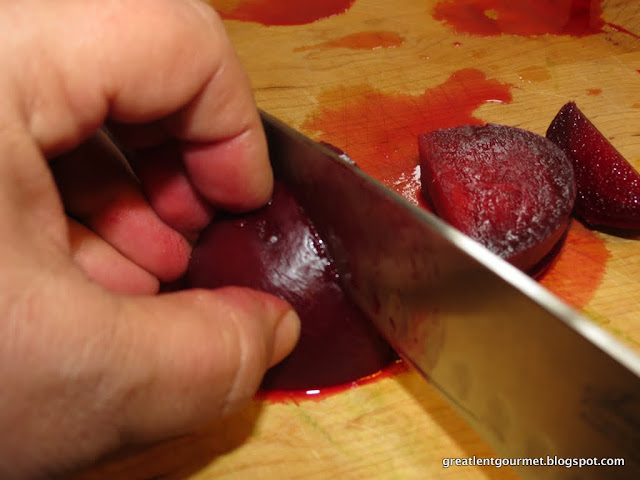During an unfortunate stay in the hospital, we were introduced to Harvard Beets. Now, beets are something we eat at home, but we typically eat them the same two ways -- roasted in the oven or served with oil, vinegar, and onions. We were not familiar with Harvard Beets at all. But, after tasting them in the hospital, we really liked them, and went searching for a little history of the dish and a good recipe. We found one! And, so many people comment on how hospital food is not good, but these were quite nice. So, here we go ...
For this recipe, you will need the following:
For the beets:
2 beets
3 cups water
For the sauce:
1/2 TBSP cornstarch
1/2 TBSP sugar
pinch of salt
1/3 cup water
1 1/2 TBSP vinegar
Boil the beets. They take a while to boil whole, but they are easier to peel if you do it this way. Trim off the top and the bottom of the beet, and drop it in the pot. You don't even have to wash the beets! Fill the pot with water, then put it on the stove on high heat to boil. Beets take about 30 minutes to fully cook through the center. To check for doneness, stab through the thickest part with a knife or a fork. If the beet slides off the knife or fork easily, then the center is cooked. That's what you want and need for this recipe. If the beets are at all undercooked, they will interfere with the final product's velvety mouth feel.
Now, it is time to peel the beets. Typically, we will dump the entire contents of the pot (water and beets) into the sink with the cold water running over the beets. In fact, we find that the easiest way to peel beets is under the cold (or cool) running water. This does a few things -- first, it cools the hot beet so you can handle the temperature; second, the skins are so soft that the water pressure helps pull the skin off for you; third, the running water helps to wash away the red beet juice that typically stains your hands, so the stain that does remain is minimal. Just rub your fingers over the beet, and the skin gets peeled away. The water will do the rest. Once all the beets are peeled, set them aside so they are completely cool enough to handle so you can cut them. In the meantime, make the sauce.
To make the sauce, you are going to put all the ingredients into a pot and mix well. The mixture will look very milky white and thin, but you have to remember that cornstarch needs to boil to "work" and thicken. And, the colour will clear as the sauce cooks, so put it all in the pot and bring it to a boil. Cook this for about 3 minutes, stirring continuously to avoid lumps from the cornstarch. Turn off the heat and let the sauce set for five minutes while you cut the beets.
Cut the beets and put them into a large mixing bowl. It should be large enough to mix the beets and the sauce without spilling over the sides. We cut our beets a little bigger than the traditional small dice, not realizing that part of the thrill of this dish was having the beets cut into little cubes. Cut them how you like, but remember that the small dice is the traditional method of this dish.
Now, pour the sauce into the mixing bowl with the beets and mix it all around. Make sure that all the beets get coated with this sauce. It will seem like you don't have quite enough sauce to cover the amount of beets in the bowl, but as you mix, you will see that it is just right. So, mix well! You will see the beets shine and look glossy when mixed right.
Allow this to fully cool to room temperature, or put it in the refrigerator for 3 hours to allow the sauce to gel around the beets. Serve cool, but not cold.
We were very happy that we did not have to be in the hospital to enjoy Harvard Beets this time. And, with the simplicity of this dish we can enjoy them whenever we want (yes, preparing beets may be time consuming but very rewarding). Somewhere we read that using canned beets for this recipe works very well, so we may try that some time. Many of the beets in a jar, however, have a lot of sugar added to the brine -- and when we tried this recipe with such beets the dish did not feel right. But, for our kitchen, usually fresh is better for most dishes. You choose what is best for you, so please let us know how it turns out.
"Good words are a honeycomb,
And their sweetness is a healing of the soul"
Book of Proverbs: Chapter 16:22






















No comments:
Post a Comment